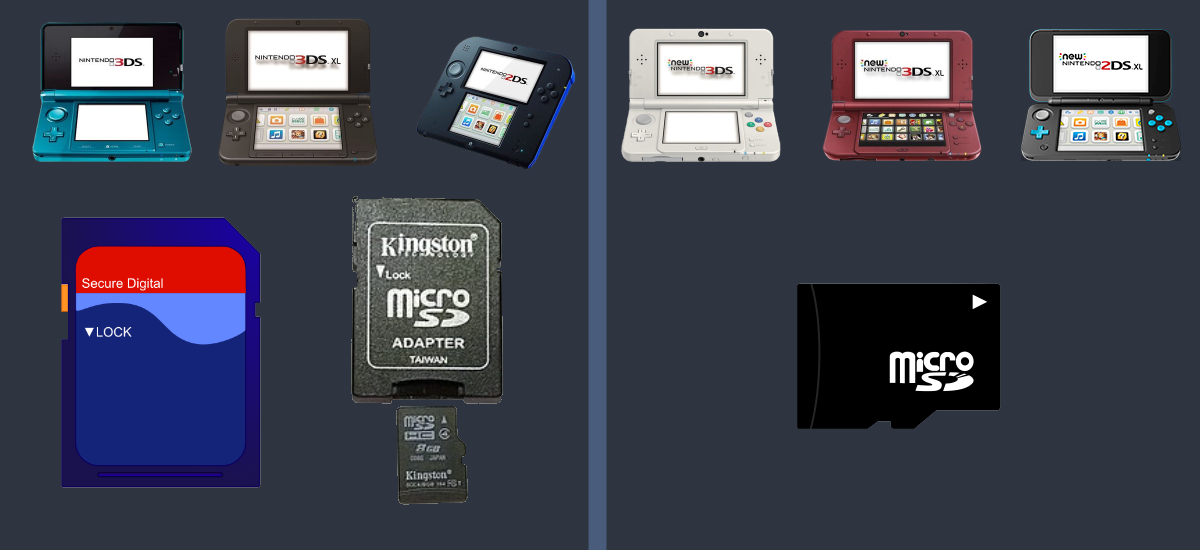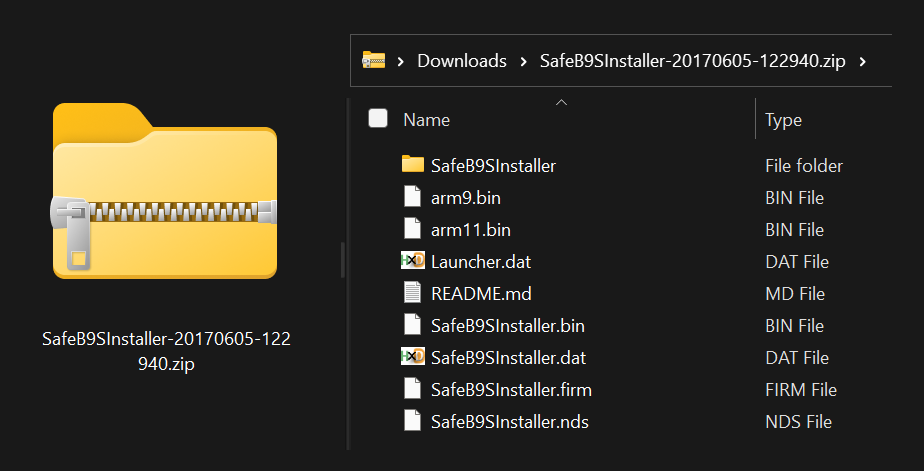Key Information
INFO
If this is your first time modding a 3DS (or you're unfamiliar with technology), keep reading! Otherwise, if you have prior experience and know what you're doing, continue to Get Started.
This page covers some of the base computer terminology and 3DS-specific information that you should know before following this guide.
Each section is collapsed by default. Click or tap on the name of the section to open it.
Compatibility
What consoles is this guide compatible with?
INFO

This guide works with every retail console in the Nintendo 3DS family of consoles (including the 3DS, 3DS XL/LL, 2DS, New 3DS, New 3DS XL/LL, and New 2DS XL/LL), regardless of region or firmware. It is NOT compatible with the DSi family of consoles (DSi, DSi XL/LL). For DSi-family consoles, consult this guide instead.
What kind of computer / hardware do I need to follow this guide?
INFO

In most cases, you can follow this guide as long as you are able to download files from the Internet and copy them to your SD card. This includes most consumer electronic devices, such as computers running Windows, macOS, Linux, and chromeOS (Chromebooks), as well as phones and tablets running Android and iOS. Depending on your electronic device, you may need to purchase an SD card adapter to allow it to read your SD card.
What kind of SD card does my console use/need?
INFO

The location of the SD card slot and the type of SD card that is accepted depends on the model of your 3DS. More information can be found on Nintendo's official support page.
The 3DS can read SD cards of any capacity (even those larger than 32GB), but the card must be formatted as FAT32 (not exFAT or NTFS). You can use one of the following tools to format your SD card, depending on your operating system: Windows, macOS, Linux. SD cards larger than 128GB are not recommended due to known issues with custom themes and GBA/DS graphics.
INFO
It is highly recommended to only use one SD card with a console at any given time, as you cannot merge the contents of two SD cards later on. So, if your console already has an SD card, you should use that SD card to mod your console, or copy everything to a larger SD card before or after you mod it.
WARNING
To follow this guide, you'll need an SD card with a capacity of at least 2GB.
INFO
If you want, you can check your SD card for errors before following this guide using H2testw (Windows), F3 (Linux), or F3XSwift (Mac).
WARNING
Potential risks (Disclaimer)
By modding your console, you subject it to the remote (but non-zero) possibility of the console being bricked (rendered non-functional). Incorrect file placement will NOT brick your console, but purposely skipping instructions might.
In short: Modding your console is safe, but it's your responsibility if something goes wrong.
Important terminology
WARNING
Following this guide alone should not result in data loss, but SD card corruption is always a possibility. You should make a backup of your SD card contents (especially the Nintendo 3DS folder) if you have important data.
What does "root of SD" or "/luma/" mean?
INFO

When copying files to the SD card, it is important to copy them to the right location - otherwise, the console will not detect the file and the exploit or software you are trying to use will not work. A term you will see frequently on this guide is root of the SD card, which means you are not inside any folder on your SD card. The directory that appears when you first open your SD card on your computer is called the 'root'.
You may also see folder names indicated like this: /folder/. The slashes are used to indicate directories and are not part of the name of the folder. For example, /folder1/folder2/ would refer to folder2 inside of folder1:
INFO

Angle brackets (< and >) are also occasionally used to refer to system-specific identifiers. For example, if the guide says <ID0>, it is referring to the system-specific identifier inside of the Nintendo 3DS folder, rather than a folder literally named "ID0":
INFO

How do I download files from GitHub?
INFO

In this guide, you will copy files that are downloaded on your computer/phone to your console's SD card. Many of these files come from GitHub, which is a website used by developers to publish their open-source releases. When downloading files from GitHub, you should download the file that isn't source code.
How do I extract/open a ZIP file?
INFO

Some of the files that you will be asked to download come in the .zip file format, which is used to package multiple files into one file.
When you are told to "copy (file) from (file).zip", that means that you need to open (or "extract") the ZIP file. Inside the ZIP file will be the file you're looking for, after which you can copy it to the specified location on your SD card.
On most operating systems, you can extract files by double-clicking the file. If this doesn't work, you can install a reputable third-party extraction tool like 7-zip instead.
WARNING
The Windows application "WinRAR" is specifically known to cause compatibility issues with the 3DS, particularly with custom firmware installation exploits. If you are on a Windows computer, you should use either the default File Explorer or 7-zip to extract files.
What are file extensions?
INFO

If your computer is running Windows, file extensions may be hidden by default, which may make it harder to find the files you're looking for. To enable file extensions, follow these instructions.
Getting help
If you experience an issue while following this guide, there are many ways that you can get help!
- If you have any questions that haven't been answered on this page, their answers might be in the Pre-Installation FAQ.
- If you experience an issue while following this guide, you can check the Troubleshooting page for a solution.
- If the resources we've provided here aren't helping, you can get one-on-one support over at Nintendo Homebrew on Discord.
TIP
Continue to Get Started